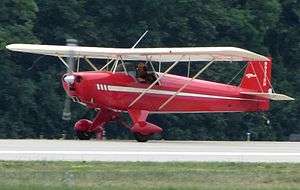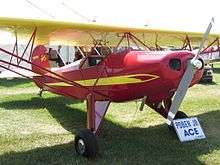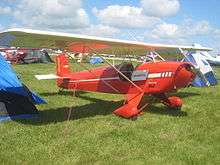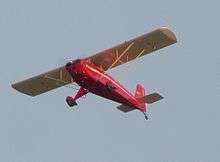Ace Junior Ace
The Ace Junior Ace is a two-seat sports aircraft that has been offered by the Ace Aircraft Manufacturing Company in kit and plans form for home building since the early 1930s. It was designed by Orland Corben.[1]
| Ace Junior Ace | |
|---|---|
 | |
| Role | Sports aircraft |
| National origin | USA |
| Manufacturer | Ace Aircraft Manufacturing Company |
| Designer | Orland Corben |
| Number built | 202 (2011)[1] |
| Unit cost |
approximately $1800 to build in 1971[2] |
It is a parasol wing monoplane of conventional taildragger configuration. Pilot and passenger sit side-by-side, in a cockpit that may be enclosed or left open. The fuselage is of fabric-covered tubular construction and the wings are wood. A variety of powerplants may be used, and the aircraft has a power range of 85 to 120 hp (63 to 89 kW).[1]



Experimental Aircraft Association founder Paul Poberezny widened the fuselage of the Jr Ace, added modern wheels, brakes and increased the span to 34 ft to create the Pober Jr Ace. The company Acro Sport maintains the rights to the design, and sells plans so the aircraft can be amateur-built.[3]
Variants
- Baby Ace
- Single seat
- Super Ace
- Single seat powered by a Ford Model A Automovie engine. Plans updated by EAA founder Paul Poberezny.
- Ace Junior Ace
- Two side-by-side seat variant.
- Pober Jr Ace
- Updated plans of the Jr. Ace model
Specifications (Model E)
Data from Jane's All the World's Aircraft 1988-9, p.647[4]
General characteristics
- Crew: one
- Capacity: one passenger
- Length: 18 ft 0 in (5.49 m)
- Wingspan: 26 ft 0 in (7.92 m)
- Empty weight: 809 lb (367 kg)
- Max takeoff weight: 1,335 lb (606 kg)
- Powerplant: 1 × Continental C85 air-cooled flat four, 85 hp (63 kW)
Performance
- Maximum speed: 113 kn (130 mph, 209 km/h)
- Cruise speed: 91 kn (105 mph, 169 km/h)
- Service ceiling: 10,500 ft (3,200 m)
- Rate of climb: 600 ft/min (3.0 m/s)
References
- Vandermeullen, Richard: 2012 Kit Aircraft Buyer's Guide, Kitplanes, Volume 28, Number 12, December 2011, page 37. Belvoir Publications. ISSN 0891-1851
- Leo J. Kohn (Winter 1971). "The true cost of building your own plane". Air Trails: 63.
- "Pober (Corben) Junior Ace". Retrieved 2 August 2010.
- Taylor, John W. R.; Munson, Kenneth. Jane's All the World's Aircraft (1988-9 ed.). London: Jane's Information Group. p. 647. ISBN 0 7106-0867-5.
External links
| Wikimedia Commons has media related to Ace Junior Ace. |